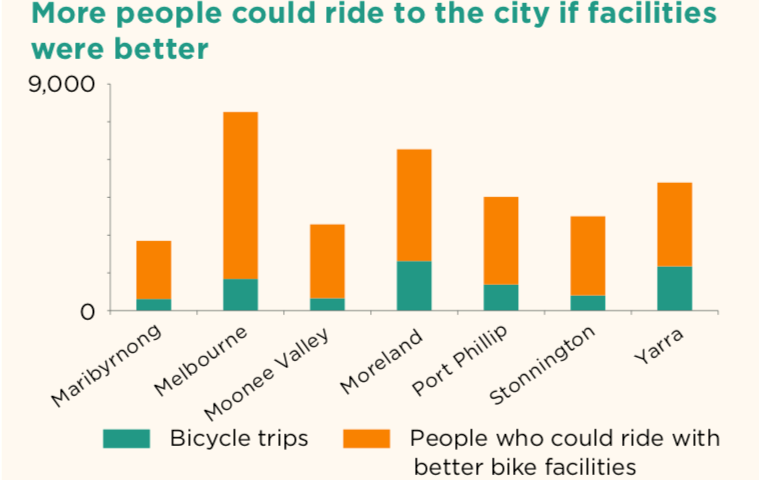The City of Melbourne has called on the powerful business community to support and incentivise bike riding in Melbourne.
It wants Melbourne to follow a campaign in London where big business strongly backed the roll out of a protected cycle lane network in central London
The idea comes from a new transport strategy discussion paper, Bicycles for Everyday Transport, released today.
Other ideas include more road space for bikes to enable better lanes and intersections, more traffic calming, and a stronger culture of sharing and courtesy.
As well as a discussion paper the council also released a research report that examines the market for potential bike commuters into central Melbourne, and asks what infrastructure might get them riding.
You can provide feedback to the City via an online portal with a link to this below.
The papers were released as part of a refresh of the Melbourne Transport Strategy.
There have been previous discussion papers on walking, public transport, city space and emerging technology.
Central Melbourne is Australia’s bike commuting success story, with more than 12,000 commuting into the CBD each day.
That’s enough to fill 57 of Melbourne’s biggest trams, with each tram costing $13.7 million. And bikes carry 1.6 times more commuters in the Melbourne municipality than do buses.
But research by the City, and separately by Infrastructure Victoria, has recently found a huge additional pool of people that could also be riding if infrastructure could be better.
Given that there is no opportunity in the future for more motor traffic into inner Melbourne, employment and economic growth will be dependent on getting more people riding.
Luckily bike infrastructure is comparatively economical to provide quickly. Unluckily, when it comes to signing the cheques to fund it, politicians have a boxing glove on their writing hand.
Lord Mayor Sally Capp said increasing cycling participation would unlock far reaching benefits to Melbourne's congestion problems and boost the economy.
"I love getting on my bike and plan on cycling to work at Town Hall as much as possible," the Lord Mayor said.
"I'm particularly passionate about getting more women on bikes because our research shows that the number of men riding to work in the city is double that of women making the same trip.
“Aside from the personal health benefits when people choose to ride they reduce vehicle emissions, noise and congestion and help free-up public transport capacity."
I want to see more women cycling in Melbourne. 🚲 Research shows the number of men riding to work in the city is double that of women making the same trip. Cycling reduces vehicle emissions, congestion & helps free up public transport capacity. Read more: https://t.co/eq7ZGLApFX pic.twitter.com/WptaNX6e67
— Sally Capp (@SallyCapp_) May 31, 2018
City of Melbourne research found that safety concerns, potential conflict with other road users, blocked and disconnected bike lanes and a lack of infrastructure to support bicycle use (such as lockers, bicycle parking and showers) prevent many people from riding a bike.
Despite bike crashes per cyclist reducing by almost 50 per cent between 2009 and 2014, safety concerns remain the biggest barrier to commuting by bicycle.
Protected lanes with a physical barrier between cars and bicycles would improve rider confidence from 22 to 83 per cent for potential city cyclists, according to City of Melbourne research.
"We need to make cycling safer to allow more women, older and younger people to ride to the city," the Lord Mayor said.
“Evidence from other great cycling cities around the world has shown this can be done.”

Other points in the discussion paper include:
- Increased investment in bike infrastructure from all levels of Government
- Electric bikes enabling longer range trips
- Bike lanes right to intersections
- More bike parking in more places
- Reduced car use
- Properly regulated dockless bike share
Click here to read the City of Melbourne discussion paper
Click here to read the City of Melbourne research report
Click here to provide feedback
Become our friend
Find out more about Bicycle Network and support us in making it easier for people to ride bikes.


